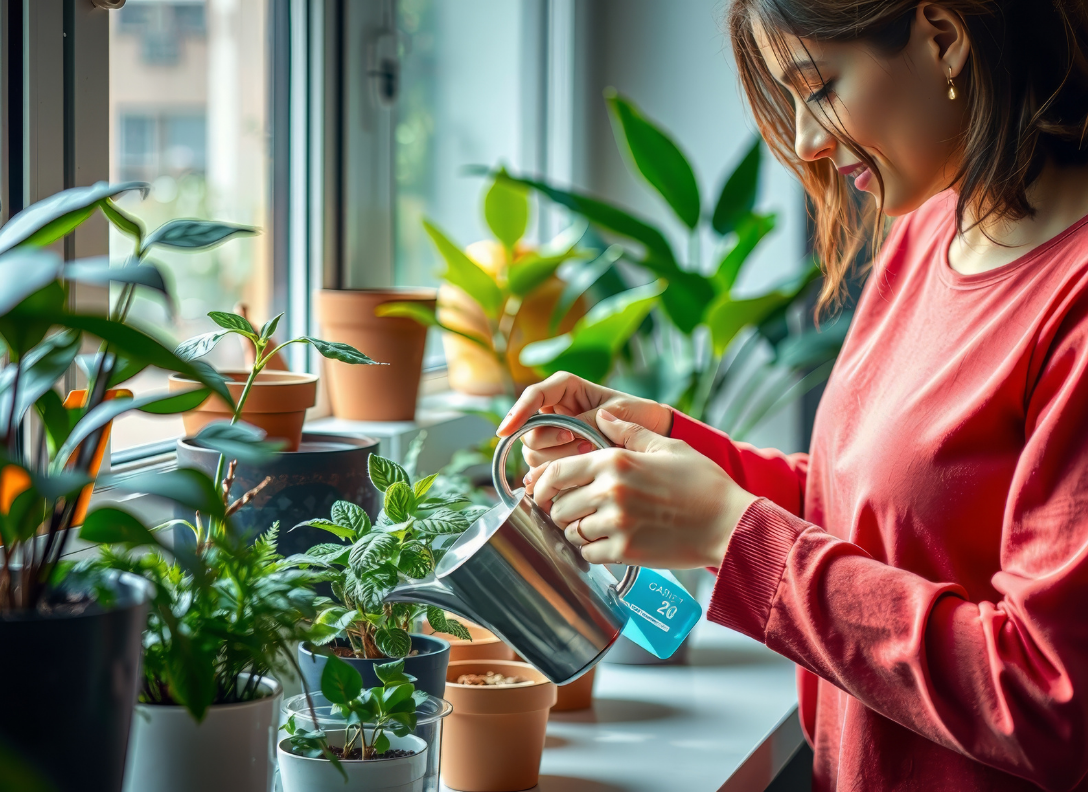You brought home a beautiful houseplant full of life and promise… only to watch its leaves droop, turn yellow, and eventually fall off. Sound familiar? You’re not alone. Millions of people struggle to keep houseplants alive even with the best intentions. But here’s the good news: it’s rarely because you “don’t have a green thumb.” More often, it comes down to a few basic care mistakes that can be easily fixed.
Houseplants thrive indoors when their basic needs for light, water, soil, and humidity are met. The problem is, indoor conditions rarely match their natural environments. A tropical plant might be sitting in a dark corner, or a cactus might be getting watered like a fern. These mismatches shorten plant lifespans.
The secret to keeping houseplants alive longer is understanding their specific requirements and building a consistent care routine that mimics their natural conditions. Once you learn these essentials, most plants become surprisingly resilient and instead of being “plant killers,” beginners quickly become confident plant parents.
In this guide, we’ll cover everything you need to know:
- The top mistakes people make with houseplants.
- Practical strategies for watering, lighting, and soil.
- Tips for humidity, pruning, and repotting.
- Pest control and disease prevention.
- Long-term routines to keep plants thriving for years.
We’ll also answer the most common questions new plant owners ask and end with a step-by-step action plan you can apply today.
Why Houseplants Die Prematurely
Before we focus on solutions, it’s important to understand the root causes:
- Overwatering or underwatering – the #1 killer.
- Improper lighting – plants in the wrong spot slowly decline.
- Poor soil or drainage – roots suffocate in heavy, compacted soil.
- Ignoring humidity needs – tropical plants in dry indoor air struggle.
- Neglecting repotting – roots outgrow containers and starve.
- Pests and diseases – often ignored until it’s too late.
- Inconsistent care – skipping waterings or moving plants constantly.
Good news: all of these are fixable with simple routines.
Watering: The #1 Factor in Plant Lifespan
- Overwatering drowns roots and causes root rot.
- Underwatering stresses plants, leading to crispy leaves.
Best Practices
- Use the finger test: insert your finger 1–2 inches into the soil; water only if dry.
- Water deeply until excess drains from the bottom, then empty saucers.
- Match frequency to plant type: cacti (every 2–3 weeks), tropicals (weekly), ferns (keep slightly moist).
- Adjust for season: most plants need less water in winter.
Light: The Food Source for Plants
- Plants need photosynthesis to survive without enough light, they starve.
Types of Light
- Bright, direct light: South-facing windows (good for succulents, cacti).
- Bright, indirect light: East/West windows (great for monstera, pothos, snake plant).
- Low light: Corners or shaded rooms (best for ZZ plants, cast iron plants).
Tip: Rotate plants every 1–2 weeks for even growth.
Soil & Drainage
- Heavy garden soil suffocates roots indoors.
- Use well-draining mixes matched to plant type:
- Cacti & succulents → sandy mix.
- Tropicals → peat & perlite.
- Orchids → chunky bark mix.
- Always choose pots with drainage holes.
Humidity & Temperature
- Most houseplants are tropical → prefer 40–60% humidity.
- Indoor heating/AC often drops humidity to 20–30%.
Solutions
- Mist leaves (though effect is temporary).
- Place plants on a pebble tray with water.
- Use a humidifier near groups of plants.
- Avoid placing plants near drafts, heaters, or vents.
Feeding & Fertilizing
- Plants in containers exhaust nutrients faster than outdoor plants.
- Use balanced liquid fertilizer every 2–4 weeks during active growth (spring/summer).
- Reduce feeding in fall/winter when growth slows.
Pruning & Cleaning
- Remove yellow/brown leaves to redirect energy.
- Trim leggy growth to encourage bushiness.
- Wipe leaves with a damp cloth to remove dust (improves photosynthesis).
Repotting: The Secret to Longevity
- Most plants outgrow pots every 1–2 years.
- Signs: roots circling surface, pushing out of drainage holes, soil drying too fast.
- Choose a pot 1–2 inches larger than current.
- Refresh soil during repotting for new nutrients.
Pest & Disease Prevention
- Common pests: spider mites, mealybugs, fungus gnats.
- Prevention: inspect plants before buying, isolate new arrivals, clean leaves.
- Natural fixes:
- Neem oil spray.
- Soapy water rinse.
- Sticky traps for gnats.
Long-Term Care Routine (Sample Weekly Plan)
- Monday: Check moisture, water as needed.
- Wednesday: Rotate plants for light.
- Friday: Wipe dust from leaves.
- Sunday: Quick pest check and pruning.
Consistency keeps plants stress-free and thriving.
FAQs
Q1: How do I know if I’m overwatering or underwatering?
Overwatering symptoms: yellow leaves, soft stems, musty soil smell. Underwatering symptoms: brown crispy edges, wilting leaves, dry compacted soil. The best method is the finger test or using a moisture meter. Remember: it’s better to underwater slightly than overwater—most houseplants recover from dryness, but root rot is often fatal.
Q2: What are the easiest houseplants for beginners?
Start with hardy plants that tolerate neglect:
- Snake plant (Sansevieria): survives low light and infrequent watering.
- Pothos: grows in water or soil, thrives in varied light.
- ZZ plant: extremely low-maintenance, drought-tolerant.
- Spider plant: adapts to many conditions and propagates easily.
- Peace lily: forgiving and shows clear signs when thirsty.
These “starter plants” help you practice without fear of quick failure.
Q3: Can I really grow plants in low light corners?
Yes, but choose the right species. Low-light champions include ZZ plants, cast iron plants, pothos, and snake plants. However, “low light” doesn’t mean “no light.” Even shade-loving plants need indirect light from windows or artificial grow lights. If your plant is stretching or turning pale, it’s begging for more light.
Q4: How do I handle pests without harsh chemicals?
Prevention is best: inspect new plants before bringing them home. If pests appear:
- Spider mites → wipe leaves with soapy water, increase humidity.
- Mealybugs → dab with rubbing alcohol on cotton swabs.
- Fungus gnats → let soil dry between watering, use sticky traps.
Natural sprays like neem oil are safe indoors. Avoid chemical pesticides, especially in homes with kids or pets.
Q5: Do houseplants really improve air quality?
Yes, but not dramatically. Studies (like NASA’s famous 1989 Clean Air Study) showed plants absorb toxins like benzene and formaldehyde. However, you’d need dozens of plants to purify an entire home. The bigger benefits are psychological: plants reduce stress, improve focus, and bring natural beauty indoors.
Q6: How often should I repot houseplants?
Most houseplants need repotting every 1–2 years. Signs: roots circling inside the pot, soil draining too quickly, or slowed growth despite proper care. Spring is the best season for repotting, as plants enter active growth. Use fresh soil and a pot only slightly larger to prevent waterlogging.
Q7: Why do the leaves on my houseplant turn yellow?
Yellow leaves can mean:
- Overwatering (most common).
- Low light exposure.
- Nutrient deficiency.
- Natural aging (older leaves eventually die).
The fix is to evaluate your routine: check moisture, reposition plant, and ensure fertilization during growing months.
Keeping houseplants alive longer isn’t about luck—it’s about creating conditions that match what they need in nature. Most indoor plants die because of common, fixable mistakes: too much water, too little light, poor soil, or neglecting humidity. Once you master these basics, plants not only survive but thrive for years.
The best approach is to:
- Choose resilient plants if you’re a beginner (snake plant, pothos, ZZ).
- Follow a simple routine—check soil weekly, rotate for light, clean leaves.
- Repot regularly to refresh soil and give roots space.
- Match plant type to location don’t put a cactus in a dark corner or a fern in a hot, dry room.
- Pay attention to signals drooping, yellowing, or stretching leaves tell you what’s wrong.
The reward of long-living houseplants is more than decorative. They become part of your daily environment—calming, cleansing, and connecting you to nature indoors. Caring for them builds patience, mindfulness, and even pride as you watch them flourish.
Action step: Pick one struggling houseplant in your home right now. Move it to a brighter spot, check its soil moisture, and trim any dead leaves. Within weeks, you’ll see new growth and realize that keeping plants alive isn’t about perfection—it’s about small, consistent care.
Start with the basics in this guide, choose plants suited to your lifestyle, and you’ll transform from a plant “killer” to a plant keeper. With consistency, your houseplants can thrive for years—even decades.




